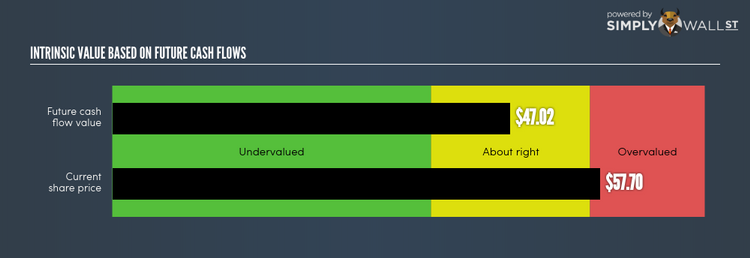Is AXIS Capital Holdings Limited (NYSE:AXS) Expensive For A Reason? A Look At The Intrinsic Value

Valuing AXS, an insurance stock, can be daunting since these financial firms generally have cash flows that are impacted by regulations that are not imposed upon other industries. Industry-specific factors, such as gross written premiums are crucial in understanding how insurance companies make money. Looking at data points such as book values, as well as the return and cost of equity, can be useful for determining AXS’s value. Below I will take you through how to value AXS in a fairly accurate and straightforward approach. Check out our latest analysis for AXIS Capital Holdings
What Is The Excess Return Model?
Before we begin, remember that financial stocks differ in terms of regulation and balance sheet composition. AXS operates in Bermuda which has stringent financial regulations. In addition, insurance companies generally don’t hold large amounts of physical assets on their books. While traditional DCF models emphasize on inputs such as capital expenditure and depreciation, which is less useful for a financial stock, the Excess Return model focuses on book values and stable earnings.
The Calculation
The main belief for Excess Returns is, the value of the company is how much money it can generate from its current level of equity capital, in excess of the cost of that capital. The returns above the cost of equity is known as excess returns:
Excess Return Per Share = (Stable Return On Equity – Cost Of Equity) (Book Value Of Equity Per Share)
= (8.1% – 9.46%) * $58.38 = $-0.79
Excess Return Per Share is used to calculate the terminal value of AXS, which is how much the business is expected to continue to generate over the upcoming years, in perpetuity. This is a common component of discounted cash flow models:
Terminal Value Per Share = Excess Return Per Share / (Cost of Equity – Expected Growth Rate)
= $-0.79 / (9.46% – 2.47%) = $-11.35
These factors are combined to calculate the true value of AXS’s stock:
Value Per Share = Book Value of Equity Per Share + Terminal Value Per Share
= $58.38 + $-11.35 = $47.02
Relative to the present share price of $57.7, AXS is priced above its true value. Therefore, there’s no benefit to buying AXS today. Valuation is only one side of the coin when you’re looking to invest, or sell, AXS. There are other important factors to keep in mind when assessing whether AXS is the right investment in your portfolio.
Next Steps:
For insurance companies, there are three key aspects you should look at:
Financial health: Does it have a healthy balance sheet? Take a look at our free bank analysis with six simple checks on things like leverage and risk.
Future earnings: What does the market think of AXS going forward? Our analyst growth expectation chart helps visualize AXS’s growth potential over the upcoming years.
Dividends: Most people buy financial stocks for their healthy and stable dividends. Check out whether AXS is a dividend Rockstar with our historical and future dividend analysis.
For more details and sources, take a look at our full calculation on AXS here.
To help readers see pass the short term volatility of the financial market, we aim to bring you a long-term focused research analysis purely driven by fundamental data. Note that our analysis does not factor in the latest price sensitive company announcements.
The author is an independent contributor and at the time of publication had no position in the stocks mentioned.

